Hokepoints: Would Bill Walsh Draft This Team?

I'm trying out a new feature of mouse-over tags so readers who don't get some of our references can get caught up. Underlined text has a tag. If the tag is a link then you've found a link. I appreciate any feedback on its deployment.
Left: Young Wolverines some of whom were recruited for power (Upchurch). Right: Power.
Chris Brown's recent article on Smart Football included a link to a 1997-vintage article by Bill Walsh (YTBW). Chris included it as a way of crediting Walsh for correctly predicting Tony Gonzalez would become a great NFL tight end. With Michigan transitioning further toward a Walsh-ian offense, I thought I'd appropriate the whole article to see how well Michigan's 2013 offensive roster matches Walsh-ian archetypes.
Before we jump in, you'll recognize a lot of what's said here from like every NFL draft report ever. Walsh's coaching tree perforated the league for years, and that meant the things he tended to look for in players became what most of the people making draft decisions were looking for. They've been repeated so often as to become memes, however I still think going back to the source can provide some insight into how Michigan's players and recruits are being evaluated.
This is all intended to help you do your own scouting when we publish things like Hello posts (lots of those coming up) and positional previews.
Quarterback
Tom Brady prototype, Tom Brady, Tom Brady with legs? --Bryan Fuller
Walsh Says: 6'3, 210. Having a strong arm isn't as important as an "inventory" of passes, although decent arm strength is a necessity:
"Arm strength is somewhat misleading. Some players can throw 80 yards, but they aren't good passers. Good passing has to do with accuracy, timing, and throwing a ball with touch so it is catchable…
"Remember, the goal of passing a ball is to make sure it is caught ... by your intended receiver."
The most important characteristic for a quarterback is intuition/instincts. He has to be able to sense the rush, make the right decision quickly and get the ball "up and gone," and handle progressions and broken plays with grace as opposed to a sense of urgency.
"The single trait that separates great quarterbacks from good quarterbacks is the ability to make the great, spontaneous decision, especially at a crucial time."
Walsh wants his quarterback to be "courageous and intensely competitive." He also wants them mobile and defines it thus:
Mobility and an ability to avoid a pass rush are crucial. Some quarterbacks use this mobility within the pocket just enough so they are able to move and pass when they "feel" a rush. But overall quickness and agility can make a remarkable difference. As an example, there were some very quick boxers in Sugar Ray Leonard's era, but he was quicker than they were and because of that he became a great champ.
Walsh's Favorite Wolverine: Tom Brady, obviously. Tate Forcier.
What to look for in a Scouting Report: High accuracy plus high YPA. "Makes things happen."
What you can learn on film: Doesn't make you nervous. Escapes from pressure then seems calm, not rushed. Sees something and reacts quickly. Receivers aren't making tough catches or breaking stride.
What could signal bust potential: First a warning on this part not to take it as "anyone who exhibits this trait will bust." What I'm saying is beware a guy ranked highly because this feature he possesses, which is a good thing to possess, may be overrated. Here it's arm strength—more an NFL problem than college since college QBs can learn systems and Navarre their way to great college careers with only one type of pass. Arm strength with no accuracy and a terrible delivery can turn into a great player if he's got an innate sense (think Stafford), but more often a coach will try to fix it and end up with a Dontrelle Willis.
How our guys compare: So far only Devin Gardner has seen substantial play against college defenses but we've gotten about a game's worth of Russell Bellomy too. Gardner's inventory has passes for finding Gallon 40 yards downfield, zips that only Dileo can get to, and even that Stafford-y thing he flipped to Dileo in the Outback Bowl. He has ideal size, and wins the mobility category over everybody not named Denard Robinson. If you give him a lane to pick up yards with his legs he will take it. And he MAKES PLAYS, those coming first to mind being where he runs around in the backfield defying sack attempts until something worthy of forward progress appears.
His weakness so far has been in that crucial "up and gone" aspect. His delivery has a long wind-up and that exacerbates a medium-to-mediocre diagnosis-reaction speed. Previous spring games when Devin looked really bad at this suggest it wasn't a few months as a receiver to blame, although that obviously didn't help. Gardner will live and die by his scrambling and ability to make linebackers freeze in coverage when he takes a step forward. He's not Tom Brady, but Gardner's package can equal a helluvah good college QB. An offseason as quarterback in a system designed to his strengths puts the ceiling high for 2013, and off the charts if there ends up being a 2014.
Russell Bellomy (right-Upchurch) in his few appearances last year—mostly the 2nd half 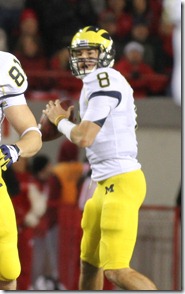 against Nebraska—gave us a fairly strong indication of his abilities. He wins Walsh points by having a catchable ball, but there it ends. His apparent lack of arm strength severely limits the inventory, his agility isn't anything special vs. Big Ten defenders, and while you can forgive a freshman thrust into starting for this, he showed a lot of panic. I am skeptical that he can contribute on this level unless his arm strength improves as much as I expect his comfort will.
against Nebraska—gave us a fairly strong indication of his abilities. He wins Walsh points by having a catchable ball, but there it ends. His apparent lack of arm strength severely limits the inventory, his agility isn't anything special vs. Big Ten defenders, and while you can forgive a freshman thrust into starting for this, he showed a lot of panic. I am skeptical that he can contribute on this level unless his arm strength improves as much as I expect his comfort will.
Shane Morris, now. Other than every scouting thing they can do with high schoolers, it's hard to say what he will turn out to be. The senior year performance and the thing that guy said in the Elite 11 about his primary read being taken away are marks against the Walsh archetype, but the size and arm and full inventory are there. He's too young to know if he will develop the rest.
Running Back
Terrance Flagler, A-Train, Toussaint –Upchurch
Walsh Says: Needs to be big enough to take punishment and always fall forward, but "some smaller runners play big." He uses James Brooks but of course we've got our own exempli gratia. The 1B for backs is again, instincts, though he emphasizes getting "the first four yards within the scheme and then rely on instincts to take it beyond that."
Walsh puts a high value on durability, which maybe isn't as important in college where the hits are lighter and the roster is deeper. The other thing he harps on is instinct, mentioning he got burned on this with Terrance Flagler. This is the difference between Michael Shaw and Mike Hart.
After that he goes into bonus features. If he can block he doesn't have to come off the field in passing situations. He has to be able to catch a screen and the further down the field he can threaten as a receiver the more "dimensional" the offense becomes.
Walsh's Favorite Wolverine: Anthony Thomas. Always falling forward, instinctual enough to be a kick returner before becoming the feature back.
What to look for in a Scouting Report: At least 185 lbs., thick and squat. Numbers don't tank against high-level competition.
What you can learn on film: Defenders look like bad tacklers (subtle movements by the RB make him tough to set up on). Falling forward, durability, operating in small spaces. Lots of D-I ticketed RBs will run sweeps all the time because their speed is just unfair against high school DEs. Watch the inside and zone running.
What could signal bust potential: Beware the big backs who wrack up huge high school yardage by running through terrible tacklers. It's hard to tell the guys who can subtly shift their bodies to make themselves difficult to bring down from the ones who just truck over a division full of future doctors and lawyers. One strong attribute can sometimes dominate a bad high school league, but D-I football requires several working together.
How our guys compare: Toussaint has shown the instincts and "plays big" at near the extreme for smallness. He looked on his way toward being a zone-style feature complement until having the unluckiest year in recent Michigan RB history. Justice Hayes is like Toussaint except he's yet to show those instincts. Dennis Norfleet has the playmaker thing down but there's a major difference in size between him and the other guys. Norfleet was listed at 5'7/161 last year, and Vincent Smith was put at 5'6/175. Hayes was 5'10/183 and Toussaint 5'10/202. Norfleet/Smith and Toussaint/Hayes are different tiers.
Among the plowshares, thick-trunked Thomas Rawls saw extensive action last year. The difference between him and Mark Ingram is Rawls seems to miss his hole a lot—that "first four yards" thing is a problem. I haven't seen enough of Drake Johnson yet to know if he brings anything different. None of the above (who are still on the roster) have yet to demonstrate they're any better than mediocre blockers.
Two incoming running backs come with the Walsh stamp of approval. Green is already 220 lbs. and his senior highlight reel shows him doing a lot of inside power running and finding his extra yards. Deveon Smith is already Toussaint-sized and seems to have that micro-instinctual quality that Hart had. No idea if either of these guys can block.
[The rest of the offense after you JUMP]
Fullback & U-Back
Tim Rathman, Aaron Shea, Joe Kerridge
Walsh Says: 6'1, 245. The NFL's limited roster meant Walsh kind of had to make his offense fit what kind of weapons he had at the hybrid blocker positions. When he had Roger Craig (think B.J. Askew) he got away with worse blocking to have a second RB in the backfield. When he had Tom Rathman (think Kevin Dudley) that worked too. Here's what he had to say on blocking types:
"This type fullback must be able to focus on a specific defender, find him and take him. It could be an inside linebacker, an outside linebacker or a defensive lineman. But he must know how to find him, know how to read what happens and make the play.
"That means he must be functionally intelligent enough to handle the variables that occur in order to be a consistent blocker."
Smart, girthy, compact, doesn't need to be very fast. However all fullbacks in this system had to be outlet receivers who get the ball clear of defenders. Here the job description starts to overlap with that of of the Michigan U-Back.
Walsh's Favorite Wolverine: Aaron Shea. Devastating blocker, effective runner, good receiver in the open field, etc. etc. etc.
What to look for in a Scouting Report: Girthy, weirdly high receiving YPC stats.
What you can learn on film: Ignore middle linebackers who stand still (high school is filled with Obi Ezehs) and see what he does against a defensive end trying to seal the corner.
What could signal bust potential: Overhyping a size-speed combination. Being able to move is secondary to knowing where to go. Massive high school running backs who obviously aren't college running backs sometimes get slotted as fullbacks because they've said they won't move to defense. Change of direction is a big deal (unless he's going to be a DE) that seems to get overlooked.
How our guys compare: The last Roger Craig-type was Stephen Hopkins but he's gone. The remainder are on a sliding scale of squat dedicated blocker to U-back tight end-ish receiver guy. Joe Kerridge and Sione Houma are the just-the-blocks-ma'am types; Kerridge was effective enough to dislodge Hopkins and hold scholarship freshman Houma to scant appearances. Hoke likes to joke that his blocking fullbacks will end their careers shorter than they arrived, and as of this writing Houma's height is not listed on the official roster.
Khalid Hill was brought in specifically for the U-spot and he even kinda looks like Kevin Dudley and Kevin Koger had a baby. Your ideal blocking fullback is 6'0/240 and your typical tight end maybe comes in at 6'4/220; Khalid Hill is 6'2/230. He looks like a big running back but his junior highlight reel is lots of catch-and-runs across the middle.
Wyatt Shallman is a different type of player. He's taller and bigger and more Shea-like. As a runner he kind of hops down the field so he can have his massive upper body hit the defense with maximum impact; that probably won't work so well against Big Ten linebackers.
Y-Tight End
Brent Jones, Ron Kramer, The Funchise --Upchurch
Walsh Says: 6'4-1/2, 245. Yes he actually is getting into half-inch increments. More so than the fullback, the "line" (as opposed to "move") tight end to Walsh should be a specialist. Type A is an extremely good blocker who can dominate a defensive end and give you a consistent running game. His receiving skills have to be serviceable enough that you're not tipping away one of your eligible receivers every time he goes in. Walsh wants him to have soft hands and be able to catch the ball while being hit by a linebacker, since he'll be operating as a dump-off option no further than their level. Give up all the speed for better blocking.
Type B is the opposite: a receiver who's big enough that you can teach him enough technique to be a serviceable blocker (otherwise just bring in a receiver and spread the field). On the non-receiver part of the job:
"Now when you get to blocking with this person it will be all technique. He is going to have to develop those techniques that he can use with reasonable effectiveness against defensive linemen and linebackers. His ability to absorb and learn technique is critical because he is not going to be able to play mass against mass."
There's a Type C: a guy who can be all of those things (insert Tony Gonzalez prediction). An A+ receiver/A+ blocker would be sweet, but not having that Walsh seems to prefer a guy who's an A+ in one aspect and a C in another to a guy who gets all B's.
Walsh's Favorite Wolverine: Ron Kramer's your first Type C. Jim Mandich is another. Great Type B's would be Joppru, Tuman, Clancy if you're into that sort of thing, Riemersma. Type A's are Mark Campbell, Eric Kattus, Derrick Walker, Martell Webb.
What to look for in a Scouting Report: In a blocker, good receiving stats; in a receiving type "coachability."
What you can learn on film: Can he catch the ball and take a hit? Tight ends are more likely than other guys to be getting those quick outlet passes where a linebacker arrives at the same time as the ball.
What could signal bust potential: The polymaths seem to do worse than their rankings here. Coaches will have patience with an outstanding receiver who needs time to learn blocking technique, or devastating blockers who need to develop their receiving skills. Not so much with a kid who is just okay at both. On the other hand the masters of one craft who cannot become proficient in the other also bust out.
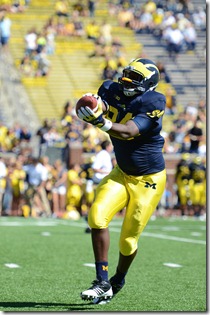 How our guys compare: Walsh would enjoy these weapons. I'm going to ignore Paskorz because he's a converted DE who was passed by two freshmen last year and start with our Type A.J. Williams (pictured at right by Bryan Fuller catching a pass I don't remember). Guys his size usually play offensive tackle and that's where scouts had him ticketed, but Michigan for now has plenty of linemen and just one real blocking type tight end on the roster. In his debut season at this A.J. was disappointing. Here's one example of many biffed blocks chosen because you get to watch some Denard & Stuff after. He did well against slower guys and when doubling, but the agile DEs spun around his blocks; he probably could have used a redshirt to work on technique before being responsible for the edge. He was rarely targeted as a receiver—Michigan kind of telegraphed its intentions when Williams was in.
How our guys compare: Walsh would enjoy these weapons. I'm going to ignore Paskorz because he's a converted DE who was passed by two freshmen last year and start with our Type A.J. Williams (pictured at right by Bryan Fuller catching a pass I don't remember). Guys his size usually play offensive tackle and that's where scouts had him ticketed, but Michigan for now has plenty of linemen and just one real blocking type tight end on the roster. In his debut season at this A.J. was disappointing. Here's one example of many biffed blocks chosen because you get to watch some Denard & Stuff after. He did well against slower guys and when doubling, but the agile DEs spun around his blocks; he probably could have used a redshirt to work on technique before being responsible for the edge. He was rarely targeted as a receiver—Michigan kind of telegraphed its intentions when Williams was in.
The other side of that coin was Funchess and he impressed enough at the thing he's a natural at to chart as a blocker with a lot to learn. He's got the A+ receiver part down; he needs to get that D-minus in blocking up a few grades. Magnus and the one coach who tells me stuff both say he's among the team's all-stars in work ethic and coachability, which suggests he's got a ceiling above the Tim Massaquoi line. Another 10 lbs. of muscle over the next two or three years gets him to the Walsh ideal.
The guy with Type C potential is incoming freshman Jake Butt. He's already 6'6-235 and enrolled early so we'll see in Spring ball if he can seize either or both roles from the sophomores. He probably leans toward Funchess's extreme and made his high school career by being a matchup nightmare—way bigger than a defensive back and way more athletic than the linebackers they could put on him. That all said I wouldn't expect him to be a Kramer right away. The ceiling for this year is probably B receiver/C blocker.
Receivers
Rice, Carter, Gallon (Upchurch|MGoBlog)
Walsh Says: 6'3, 210. That was big then and big now. This is a position you're more born into than any other. Most plays a receiver is involved in have the outcome decided by a matter of inches. If you can consistently get higher than the guy defending you, you're unstoppable. College receivers are an even greater mismatch because you kind of get to pick your matchup if you're the offense and few teams have one, let two defensive backs who can match up with an elite receiver.
That said, the first thing Walsh looks for is agility and body control—the great receivers are great mid-air contortionists. Just under that is strength—that was Roundtree's problem. The great ones also have supreme focus. "Running routes well" is a byword everyone picked up from Walsh but he doesn't mention it here—rather he talks about how receivers need to be in peak physical form. They need full-stride speed—if they get ahead of a guy they can't get caught or else the quarterback will start shorting the ball and the defense has a better shot at it. Jerry Rice wasn't the fastest guy but he wouldn't get caught once he reached his stride. Route running, it seems, is a subtlety picked up over time in an offense, not an innate ability.
Walsh almost makes a big deal about conditioning and durability—a receiver who's slowed or hurt or stiff or gasping for air gives up that all-important inch he operates in. That's a bigger deal in the NFL because teams only carry like five receivers; college teams can rotate up to seven, often have nine or so on scholarship, and always have like six walk-ons standing by just in case.
Walsh's Favorite Wolverine: Pick a #1. I went with Carter over Edwards because Anthony was the more innately talented and had that focus that Bill Walshes crave.
What to look for in a Scouting Report: Size, 40 time, vertical…here's a spot where you can actually care about the metrics scouting services can get their hands on.
What you can learn on film: Ignore the wide open stuff and see what happens when he's up against a defender. That body control is the key.
What could signal bust potential: Specialists. It seems counter-intuitive but the "possession" receivers are notorious for never managing to extend many possessions. Oh and spindly guys do well in offenses made to get them open in space but fare poorly on contested throws, which is most throws. The talent scouts tend to get this position right most of the time.
How our guys compare: Jeremy Gallon can make any molecule in his body twitch to a new position so fast it has to be measured in space-time. Unfortunately he only possesses three atoms and a couple of neutrinos, however because of the gravity field created by his near-light-speed movements, Jeremy Gallon is secretly 8 feet tall. Both of last year's freshmen (Darboh is a sophomore, Chesson a RS frosh) are pretty tall and pretty strong and pretty fast; coaches say they both still need to work on blocking. With apologies to Fred Jackson, I'm not a fan of Jeremy Jackson, who is tall but doesn't have great focus, isn't very athletic, and certainly isn't any kind of fast. The incoming freshmen are tall, not super-athletic. The coaches have struck out with some top targets for various reasons, and the kids they're bringing in this year are going to stretch Brian's YMRMFSPA creativity.
Center
Dwight Stephenson, David Molk and Protégé by Heiko|MGoBlog
Walsh Says: 6'2, 290. And thank you Bill Walsh for providing some clarity to an ongoing argument among Michigan fans as to why certain guys among the last two OL hauls are ticketed for center and others wasted there. The center is supposed to be smart enough to call the blocking assignments for the line—though a guard sometimes does that. Here's the money part:
"Centers don't often have to block one-on-one with the nose tackle, but if they can it is a great advantage. You typically slide a lineman or find a way to help the center. Or he finds a way to help someone else. Now if you have a center who can isolate one-on-one with a nose tackle, it takes tremendous pressure off your guards and everyone else."
He likes a shorter center with girth because the center needs to operate through small spaces and if he loses leverage the whole offence crinkles. "You need a center who is so quick that he can move in between people. Shorter guys can do that better than taller, rangy guys."
Walsh's Favorite Wolverine: He'd take Molk for the way he treats reporters alone.
What to look for in a Scouting Report: Academics (!), football intelligence, speed and agility, compact.
What you can learn on film: Reach and combo blocks, turning back to wall off backside pursuit, covering for other guys' mistakes, upended DTs.
What could signal bust potential: A plowhorse. Some "big uglies" make it as good centers, however the odd David Baas is more rare than the misapplied Graham Pocic.
How our guys compare: The center gets help, and that's a pretty good explanation for why Mealer not Barnum ended up there last year. This year the candidates are a redshirt sophomore with Molk comparisons, a true freshman who's a coach's kid, and maybe one of the guards getting involved.
Let's start with Jack Miller, who's of a height with Molk. You don't really get to have another guy like one of the greatest Michigan centers ever, but Miller's profile reads the same way: tough as nails, competitive, athletic, smart, kinda small. Rodriguez was fine rolling with an undersized redshirt freshman but Hoke apparently wasn't last year. That's the explanation I'm going with anyhow. Miller fits the profile if he's gotten strong enough. Not being even a whisper during last year's offensive line debacle is a black mark against him.
If it's not Miller it's…well let's imagine Joe Burzynski moves here. The onetime walk-on got some play last year at guard and would be another Mealer-like option: a guy with experience in this offense who would benefit from having help on most plays. His size was a problem last year when he was the backup guard, but that should be less so at center.
If not those guys, Patrick Kugler arrives. True freshmen almost never play at OL, and haven't except that one guy. If one can, maybe it's the son of the Pittsburgh Steelers' offensive line coach. With new starters at the guard positions as well I really don't like the idea of Kugler here yet. At 6'5/280 he's a bigger option, though that's still a long way from the kind of strength it requires to hold off a Big Ten nose tackle on your own.
Guards
Wanted: facial hair. John Ayers, Steve Hutchinson, Kyle Kalis (John T. Greilick|DetNews)
Walsh Says: 6'3, 300. And here's the key position for your offense:
"Typically, you style your offense in relation to who you have at the guard positions. You have to adapt your style to your guards."
Word, Bill. --every Michigan fan since 2008. The great guards have quickness, agility, explosion and size. They can pull, trap, or crumple any manner of defender. He can be a weaker pass blocker than the tackles so long as he's strong enough to not get knocked back—the mass of bodies protects him here. Walsh doesn't care about how much he benches; he looks for a guy who can stand his ground and checks that part off. He mentions Guy McIntyre was a guy too small for the spot despite being pretty athletic while Ayers lacked that athleticism but sufficed. This is why I moved Burzynski.
Small and agile guards can survive—Nebraska's Spencer Long at 6'4/305 is probably the best guard in the conference this year and I'd take Northwestern's Brian Mulroe, 6'4/295, over any of the monsters at Wisconsin and Ohio State. Walsh judges guards by the precision of their footwork, but really he wants to know what each guy's forte is among the myriad things a guard has to do.
That's because once a guard hits that minimum size/strength threshold to not be a liability in pass pro everything else is about executing many different and complicated types of blocks. They have to be able to time a pull right but still make it through the hole, they have to be able to come inside out to pick up linebacker blitzes, and get from Point A to Point B. Finding a master of all these techniques in the NFL is next to impossible, which is defined as finding the perfect guard in college. So Walsh believes offenses ought to start with the kinds of guards they've got and what those guards are best at, then build the offense from there.
Walsh's Favorite Wolverine: Steve Hutchinson is the nearest it comes to guard perfection—scouts thought he was a little too slow.
What to look for in a Scouting Report: Check his size and move on.
What you can learn on film: You found film on a guard? Really? Okay what's he doing? Are these highlights of him trapping, or pulling, or bowling dudes over, or going downfield like a wrecking ball on screens?
What could signal bust potential: Small and agile. Agility is a big deal, especially with the feet, however they have to get big enough to not buckle, and there's plenty of agile guards who never develop the innate awareness of what's going on around them, where to get to, and when's the right time to arrive.
How our guys compare: Okay so we fucked that one up. Patrick Omameh was a devastating 2nd level blocker who couldn't pull. Ricky Barnum if you go back is an effective combo blocker especially if you set his block up for him first, but when tasked with setting the table for Mealer…oh hell these complaints are so 2012. In 2013 we don't have any clue what they can do because they're all kiddies.
The not-kiddy option is Chris Bryant, who passes the "reacts well with gravity" test and we don't yet know much more. Insiders said he was on track to compete for a starting job last year, but they still won't say a word about his boo-boo. My own rule for rehabilitations is no news is bad news. If he's practicing come Spring ball, Bryant has to be the prohibitive favorite for one of the guard spots.
The top kiddy is redshirt freshman Kyle Kalis, who arrived nearly college ready last year and I think the coaches really wrestled whether to burn his shirt. Unfortunately for 2012 and possibly very fortunately for 2016 he did redshirt. As a recruit he was an offensive tackle just because he could hate the most donkeys that way, but he's guard size, guard length, and other than his size his footwork gets the most praise.
Among the other freshmen, Bars is a project recruit progressing ahead of schedule, and 2013 recruit Kyle Bosch is enrolling early. Dawson is another guy like Kalis but still kind of raw, and I expect he and Samuelson will redshirt. They're all really big—I can't say more until I see any of them in action.
Tackles
Steve Wallace, Jake Long, Lewan (Upchurch|MGoBlog)
Walsh Says: 6'4, 310. And here's where you need to adjust for inflation. To whit, here's Magnus when Kalis committed:
"He's 6'5". The last time Michigan had a 6'5" starting tackle was Steve Schilling, who was a poor fit so he moved to guard for his final two seasons. Before that it was Rueben Riley, who was clearly only playing tackle in 2006 because Alex Mitchell was an all-time fatty. So the last legitimate 6'5" offensive tackle (i.e. one who wasn't playing awkwardly out of position) was Adam Stenavich in 2005, who was an All-Big Ten player."
Go around the conference and there's plenty of 6'5 tackles who do just fine—Ricky Wagner, Tyler Moore and Jeremiah Sirles are all 6'6—but still, Walsh's 6'4,310 is a 1997 anachronism, not a wish for shorter than average bookends. On the other hand he doesn't give as many damns about the weight:
Of course, you could have great ones at 330 pounds, but the reality is they play well in spite of being 330. The only value of 330 is they attract the TV cameras. Some of them are not going to be 300, they are always going to be 330 or whatever. But others could be a finely tuned, highly conditioned athlete at 300, but they play at 330 and can still play.
In a tackle Walsh wants—No. 1—foot agility in a two-yard square, foot speed to a tackle is what arm strength is to the guy whose blindside he's protecting: an innate ability that can be covered but will ultimately determine the player's ceiling. The next thing is length (here's where height comes into play) of the arms and, more importantly, how well he times his extension. "The tackle must have a knack at feeling of knowing where to intersect people."
There's also an attitude for this position, which features a lot of one-on-one battles throughout the game where one loss can spell disaster—one mistake cascading into two could be the entire margin of the game.
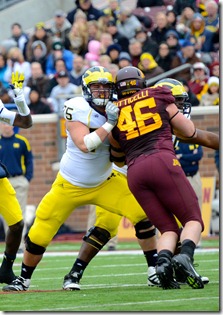 Walsh's Favorite Wolverine: Jake Long. When he was first recruited, Long was a come-lately to football but had boom potential due to his quick feet and huge frame.
Walsh's Favorite Wolverine: Jake Long. When he was first recruited, Long was a come-lately to football but had boom potential due to his quick feet and huge frame.
What to look for in a Scouting Report: Height. Maybe someone saying something about how his footwork and athleticism is incredible. "Nastiness" was a thing for a time but once scouts realized people took that as something to get excited about when it really means "he's mean to the guys he's blocking" it stopped being useful.
What you can learn on film: Watch his feet. Here's an example of really good footwork in a college OT.
What could signal bust potential: Big haws. People see a 6'8/340 17-year-old and go nuts. Remember it's an athletic 6'8/340 17-year-old you need.
How our guys compare: Taylor Lewan needs only to finish this year as the No. 1 draft pick to equal the career of Long. Michael Schofield (right: Bryan Fuller) isn't as strong as Lewan but he's nearly as agile; he can also play guard with those feet and did quite well there in 2011, however Schofield is 6'7 and "was pretty good" in the Big Ten last year at OT equals someone you don't move unless you really really want to.
That's the seniors. Let's look at the juniors.
Okay, let's look at the sophomores.
Freshmen then. Magnuson came with the fancy footwork hype but needed to put on more weight, and Braden is a huge dude who was getting the coaching buzz as being ready to play. One answer to the guard spot is if one of these guys is really ready to be the Next-Next Jake Long, Schofield can move back inside.
Of the 2013 freshmen, neither is likely to be in the mix. Logan Tuley-Tillman is a big kid who needs to work on his technique, and Chris Fox is another kind of come-lately with quick feet.
February 26th, 2013 at 3:16 PM ^
My remaining point of disagreement is that the ability to stay calm and read defenses is, to some degree, innate. He was so quick to resort to scrambling, and so consistent in the ways in which he did so, that I think it's sort of inappropriate to assume that if he'd worked a bit harder at learning the offense he would've looked something like the prototypical WCQB. From what I recall, he did the same shit in high school, too.
In other words, Forcier to me is very much more early-vintage, gun-slangin' Brett Favre than Brady or Montana. He was fairly accurate, but I still don't think he ever showed any evidence that he could be calm and composed when protection broke down. At least in 2009, I didn't really see any examples of good defenses that he really excelled against, as I remember ND's outfit being pretty mediocre. What I remember is that his rollout move was quickly accounted for by well-coached defenses like Iowa's and Ohio's, and nigh completely shut down. I've already spent way too much time looking at old stats to try my hand at 2010, though, so I'll take your word for that. Finally, since it seems to be the consensus that Rodriguez's offense can make QBs look much more efficient than they would under a WCO system, this might skew results a bit.
The final point I'd make is that I don't think you're accounting for height nearly enough. Having watched Rex Grossman and then Denard over the past several years, I've come to believe that there's a damn good reason NFL GMs treasure QBs 6'4" and taller. It's much easier to look calm and composed when you don't have to nimbly duck between Land Yacht linemen or vacate the pocket entirely in order to see downfield. There are the exceptional cases, of course - see: Brees, Drew. But Montana was 6'2" in an era when linemen were, as you point out, not as tall as they are today, and Brady is obviously a pretty tall dude. Forcier's height would be a major mark against prototype status, IME. I might go with (Sexiest Man Alive) Grbac, of whom I have admittedly fuzzy memories as being accurate, and who had a career completion percentage of 62.5% according to Wikipedia.
February 27th, 2013 at 7:57 AM ^
Calmness under pressure can completely be learned. 10000 hours makes an expert. Any operational specialist. If you put in your time doing something, you'll be an expert. You may not have the talent someone else has, but you'll have the knowledge. The knowledge will give you the calmness.
February 27th, 2013 at 11:53 AM ^
This did not work for Joey Harrington.
February 26th, 2013 at 10:28 AM ^
I complained. Kudos to Seth for having a thick skin and trying new things, that's not always or ever the easy first reaction to critical strangers online.
The mouseovers are nice, but the real thing that makes me like this post is the ratio of content to jokes/references. No longer do the jokes feel like they're overwhelming and obscuring the content. I can breeze by them or maybe even laugh at them now. Yay!
February 26th, 2013 at 4:07 PM ^
The writing style of this article wasnt anything different than what he had written before. If you see one of the references more than once, it's pretty easy to figure out what it is the writers are talking about.
February 26th, 2013 at 10:34 AM ^
This is a great article, Seth. Thanks for taking all that time to draft it. Substantively, after reading this, the situation at the receiver position in 2013 scares me now more than ever. Sure Gallon is talented but is he going to be good enough to take pressure off the running game and keep the defense from loading up the box?? I sure hope so!
February 26th, 2013 at 10:40 AM ^
February 27th, 2013 at 3:14 PM ^
and it's comparison from the prototypical to where we are now; however, FWIW, Jack Clancy was not a tight end. He was a wide receiver or "split end" as it was referred to back then. He actually started out as a running back. I believe the tight end in 1966 (Clancy's last year) was Clayton Wihite.
EDIT: Saw the note you added, and this might be a bit late, and never intended any sort of a debate in the first place, but while it is true that back then EVERYBODY blocked, including the QB, Clancy was not a blocker in any sense of the word.
First of all, he was not very big. Second, he set Michigan and Big Ten pass receiving records in 1966. Those records stood for years, and even after all these years, he remains 5th on the list All Time for receptions in a year in the Michigan record book. Even his 1965 receptions rank in the top 20 ever for Michigan (18th). There are only 2 tight ends in the records of top 20...Joppru in 2002 at 17th; and, Mandich in 1969 at 20th.
So far as I know, Clancy was the first to stay in Ann Arbor over the summer and work out. He and Vidmer, QB, worked out against Volk and Bass. They were not working on blocking. For the life of me, I cannot remember Clancy ever lining up as a tight end next to a tackle, and I was there. He was always split out....way out. Drafted by the Dolphins as a wide receiver and played very well for one year (an AFL All Star) until he hurt his knee and was done. Griese's old man was the QB for the Dolphins.
I expect that Jack would laugh like hell if he knew anyone considered him a tight end. I also expect that by your added comment above you were just being funny; which is ok of course, but not factual.
Still a great post. It provided great perspective and another view of M's status.
February 26th, 2013 at 11:03 AM ^
February 26th, 2013 at 11:07 AM ^
First, really good post and I enjoyed reading it. When I got to the guard position though, I thought that the post could have been improved significantly by going through the positions based on the order of importance from Walsh's perspective. He talks about guards, not quarterbacks or others, as the ones you style your offense around. Starting this with guards, instead of our usual progression through the offensive positions based on skill first, blockers last, would have challenged me to think more flexibly (clearly?) on how a Walsh offense should be constructed and the priorities for doing so.
February 26th, 2013 at 1:02 PM ^
February 26th, 2013 at 11:09 AM ^
Wow! That's a ton of information and insight. Thanks for posting. It's great to read what a Hall of Fame coach, known for his (then) innovative offense thought about each offensive position and how our current Wolverines fit each description.
Thanks, Seth.
February 26th, 2013 at 11:15 AM ^
"None of the above have yet to demonstrate they're any better than mediocre blockers."
You weren't referring to Vincent Smith with that comment, were you?
If so, Duuude, ... not cool!
February 26th, 2013 at 1:03 PM ^
February 26th, 2013 at 11:21 AM ^
February 26th, 2013 at 11:29 AM ^
This was a great read--so interesting to hear the Bill Walsh perspective for each group. It was definitely a very nice idea for a post. Thanks for posting!
February 26th, 2013 at 11:36 AM ^
Fantastic piece, Seth. I learned a ton about the vision of this team and how it's being put together.
February 26th, 2013 at 11:43 AM ^
I don't read Spanish.
February 26th, 2013 at 11:53 AM ^
I'd be willing to bet Schofield is stronger than Lewan but just lacks the technique and footwork that sets Lewan apart. We will have the best two OTs in the conference next year.
February 26th, 2013 at 12:06 PM ^
on potentially obscure references in more posts would be greatly appreciated. Great idea! Like some MGoUsers, I don't get most pop or cultural references posted here unless they have to do with sports in particular.
February 26th, 2013 at 10:54 PM ^
I have been reading the blog for a while and got most of the references. Now that they are explained, I laughed when I realized I got the donkey reference wrong, just like when I watch old movies on DVD with subtitles and find out that dialogue was not what I assumed it was.
I assumed the donkey mention was a reference to how Lewen is big and strong and mean and does not like donkeys, just like Shrek (at least in the first one). Guess I was wrong.
February 26th, 2013 at 12:10 PM ^
Eh, I dont get it?
February 26th, 2013 at 12:11 PM ^
Thanks so much for that. I hung on every word.
Please, please, find a similar source on Defense! On that side of the ball there just seems to be so much more grey area from one position to the next on the DL and with the OLBs.
February 27th, 2013 at 1:31 PM ^
Not exactly the same stuff that Seth just put together, but here's a few links to previous 4-3 under posts, most of the content coming straight from Mattison via Brian. Not all content is relevant, but you can find a lot of the info you're looking for if you piece different parts of them together:
http://mgoblog.com/content/coaching-clinic-notes-mattison-and-defense
http://mgoblog.com/content/clinic-items-greg-mattison
http://mgoblog.com/content/hello-again-old-4-3-defensive-line
There are a few others but I'm not spending more than 5 or 10 minutes on the Mgogoogle. Start your search with "4-3 under" and work from there.
February 26th, 2013 at 12:13 PM ^
Too Seth; didn't read
/s
February 26th, 2013 at 12:16 PM ^
February 26th, 2013 at 12:17 PM ^
February 26th, 2013 at 2:29 PM ^
Really digging the new mouse-over and linking features. Good upgrade. Prefer that over the Grantland style of note in the margin.
Also, great post in general. Really detailed and useful breakdown.
February 26th, 2013 at 2:33 PM ^
Great job, Seth. Nice, informative article- as always. Mahalo.
February 26th, 2013 at 3:26 PM ^
... I can use them if I want and ignore them if I don't.
The article content is very interesting although I have a few quibbles about Bill Walsh as "mold your offense to your players" guru. In theory, that's the first job of every coach - put your players in a position to succeed; play to their strengths and hide their weaknesses - and Walsh was excellent at doing so.
The real "breakthrough", though, is the route tree, formation-package-plays and the ability to communicate complex information in simple terms - the combination allows you to run radically different plays that look exactly the same until just after the defender has to make his critical commitment decision.
Arguably Air Coryell and the Greatest Show on Turf are the real perfection of this idea - the "we're running a pass play, but you don't know which one it is - and sometimes it's a run!" offense that executed so well and presented so many difficult matchups that you had to pick your poison and hope the refs helped you out.
February 26th, 2013 at 4:37 PM ^
February 26th, 2013 at 3:26 PM ^
Great writeup Seth
February 26th, 2013 at 3:38 PM ^
3 questions that probably goes way too much in the weeds:
Would you ideally have a difference b/n left and right tackle. My understanding is blindside makes footwork/handwork/length more important for the left than right, yes?
Is there any kind of important difference between the split end (on the line?) vs. flanker (off the line?) Why?
Is there a difference between who you'd choose as left guard vs. right guard.
Thanks, great post.
February 26th, 2013 at 4:39 PM ^
February 26th, 2013 at 7:16 PM ^
Thanks very much
February 26th, 2013 at 3:39 PM ^
This is just an outstanding article. I didn't want it to end. I'm wondering if it's possible to craft an analogous article for the defense, although I don't know if such an analog to Walsh exists on the defensive side of the ball, but it would be a great read.
Nominated to be saved as HoF content.
February 26th, 2013 at 4:08 PM ^
Strong work, Seth. It's meaty stuff like this that makes the off-season bearable.
February 26th, 2013 at 4:31 PM ^
I had this article in an open window all day and would come back to it periodically. Awesome read. Haven't felt this informed since the heady Roll Damn Tide days. /inside reference.
February 26th, 2013 at 4:55 PM ^
February 26th, 2013 at 6:05 PM ^
I really enjoyed this article, the depth of the analysis etc.
Mouseover tags - keep 'em
February 26th, 2013 at 8:29 PM ^
Growing up in Michigan as a Lions fan, it was inevitable that part of my rooting interest would stray to other teams. I initially became a 49ers fan, not because of the actually games, but because on Tecmo Bowl for (the original) Nintendo they were the best team. They had Ronnie Lott on defense, and the cheat play that always worked on offense. Down and A, Down and A, Down and A, Bomb…Touchdown.
As games progressed, I found myself sticking with SF because they had an easy offense to understand, and a lot of plays that worked against any defense. My favorite was the full back rollout that was open every time and always gained more yards than it should. That is when I noticed that in actual game, they would run this play several times and it would always work the same, full back with a lot of open space. I began to appreciate the West Coast offense, and how well it was run. They became my favorite team to watch.
When they hired Borges, my first thought was about Michigan running full back rollouts that would gain lots of yards, and great timing plays. I know the past players may not have been conducive to that type of play, but I am looking forward to seeing what this offense can do with the play caller in his comfort zone.
Great trip down memory lane, great writing, and I look forward to hopefully building a team like this in the future.
February 26th, 2013 at 9:12 PM ^
February 27th, 2013 at 12:52 AM ^
February 27th, 2013 at 11:55 AM ^
No direct connection. Our OC is a West Coast Offense guy is why it matters.
February 27th, 2013 at 4:41 AM ^
Awesome job. Great write-up.
I love me some Michigan football but I do love basketball as well, probably more than many others around here, therefore I'm definitely in basketball mode right now. I'm not a guy who follows recruiting, save for reading the "Hello: " posts on this blog and keeping a lazy ear to the street about potential commits, and basic info. like that. Point being, it's a little hard for me (TWSS) to get into much football stuff right now being as this basketball season as a whole has 97.5% of my focus/attention. This, however, was a great football post I thoroughly enjoyed and helped keep a tiny part of my attention toward the Michigan gridiron team (even in late February).


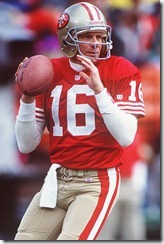

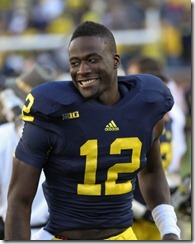
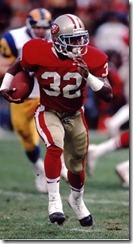
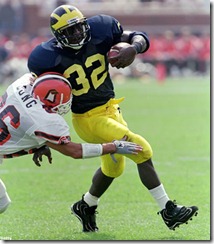
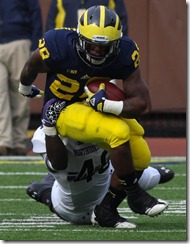
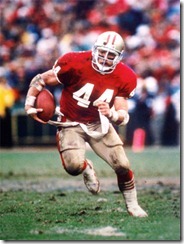

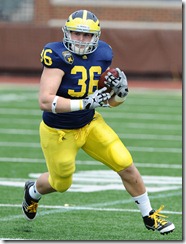
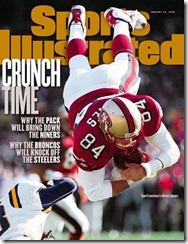


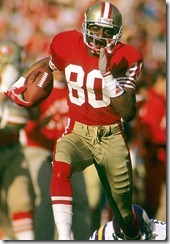
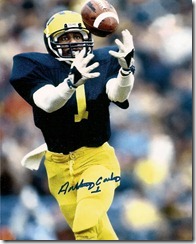
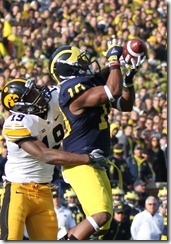
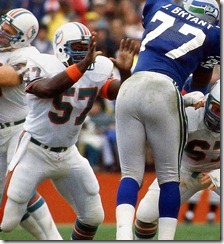
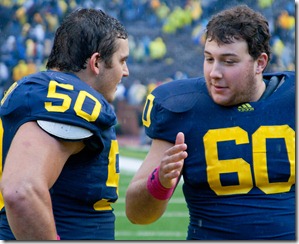
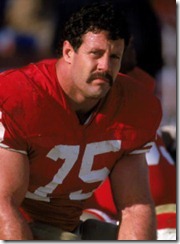
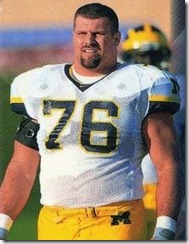

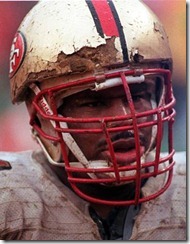
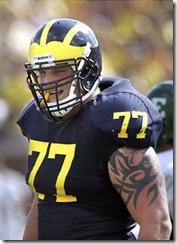



Comments